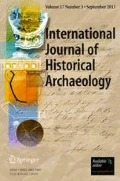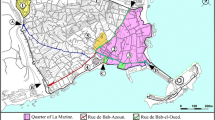Abstract
Archaeological and historical data, combined with GIS analysis gives us new perspectives on 11th c. medieval period envoy missions from the Song Dynasty (960–1279) to the Liao Empire (907–1125) Middle Capital in Chifeng Inner Mongolia, China. The envoys’ routes can be recreated on maps, and optimal route and viewshed analyses give us insight into the Liao’s concerns about these foreign missions crossing their territory and how they addressed them. Furthermore, population estimates can be made from envoy information that can be used to extrapolate population density estimates from archaeological data for other areas in Chifeng.






Similar content being viewed by others
References
Alcock, S. (ed.) (2001). Empires: perspectives from archaeology and history, Cambridge University Press, Cambridge.
Bennett, G. (2015). ‘I spy with my little eye’: GIS and archaeological perspectives on eleventh-century Song envoy routes in the Liao Empire. Medieval Worlds 1: 71–85. doi:10.1553/medievalworlds_no1_2015s71.
Bradley, R. (1984). The social foundations of prehistoric Britain, Addison-Wesley Longman Ltd., London.
Bradley, R. (1993). Altering the earth: the origins of monuments in Britain and continental Europe, Society of antiquaries of Scotland, Edinburgh.
Brosseder, U., and Miller, B. K. (2011). Xiongnu archaeology: multidisciplinary perspectives of the first steppe empire in Inner Asia. Vor- und Frühgeschichtliche Archäologie, Rheinische Friedrich-Wilhelms-Universität Bonn, Bonn.
CICARP (Chifeng International Collaborative Archaeological Research Project) (2003). Regional archaeology in Eastern Inner Mongolia: a methodological exploration, Science Press, Beijing.
CICARP (Chifeng International Collaborative Archaeological Research Project) (2011). Settlement patterns in the Chifeng region, University of Pittsburg Press, Pittsburg.
Clark, D. V., Cowie, T. G., and Foxon, A. (1985). Symbols of power at the time of Stonehenge, National Museum of Antiquities Scotland, Edinburgh.
Fang, H., Feinman, G. M., & Nicholas, L. M. (2015). Imperial expansion, public investment, and the long path of history: China’s initial political unification and its aftermath. Proceedings of the National Academy of Sciences, 201419157.
Feinman, G. M., Nicholas, L. M., and Hui, F. (2010). The imprint of China’s first emperor on the distant realm of eastern Shandong. Proceedings of the National Academy of Sciences 107(11): 4851–4856.
Han, M.L.韩茂莉 (2006) 韩茂莉, 草原与田园,辽金时期西辽河流域农牧业与环境 (Grassland and rurality: the recurrence of agriculture and livestock raising and its environment in the area of the Liao River during Liao and Jin dynasties). Sanlian Shudian: Beijing.
Hanks, B. (2010). Archaeology of the Eurasian steppes and Mongolia. Annual Review of Anthropology 39: 469–486.
Hanks, B. K., & Linduff, K. M. eds. (2009). Social complexity in prehistoric Eurasia: Monuments, metals and mobility. Cambridge University Press.
Hitchner, R. B. (2012). Roads, integration, connectivity, and economic performance in the Roman Empire. In Alcock, S., Bodel, J., and Talbert, R. J. A. (eds.), Highways, byways, and road systems in the pre-modern world, vol. 9, Wiley, Chichester, pp. 222–234.
Hodder, I. (1990). The domestication of Europe, Blackwell, Oxford.
Honeychurch, W. (2015). Inner Asia and the spatial politics of empire; archaeology, mobility, and culture contact, Springer, New York.
Honeychurch, W., Wright, J., and Amartuvshin, C. (2009). Re-writing monumental landscapes as Inner Asian political process. In Hanks, B. K., and Linduff, K. M. (eds.), Social complexity in prehistoric Eurasia: monuments, metals, and mobility, Cambridge University Press, Cambridge, pp. 330–357.
Hyslop, J. (1984). The Inka road system, Academic, Orlando.
Kieschnick, J. (2003). The impact of Buddhism on Chinese material culture, Princeton University Press, Princeton.
Lin, H. (2009). Urban landscape and politics: the making of Liao cities in southeast Inner Mongolia, Unpublished PhD thesis, University of Chicago.
Lin, H. (2012). Legitimacy and control: the making of the imperial Liao heartland. In Hartley, C. W., Yazicioglu, G. B., and Smith, A. T. (eds.), The archaeology of power and politics in Eurasia; regimes and revolutions, Cambridge University Press, New York.
Maas, M., and Ruths, D. (2012). Road connectivity and the structure of ancient empires: a case study from late antiquity. In Alcock, S., Bodel, J., and Talbert, R. J. A. (eds.), Highways, byways, and road systems in the pre-modern world, 5th ed, p. 255.
Matos Mendieta, R., and Barreiro, J., eds. (2015). The great Inka road: engineering an empire. National Museum of the American Indian in association with Smithsonian Books: Washington, DC.
Sinopoli, C. (1994). The archaeology of empires. Annual Review of Anthropology 23: 159–180.
Sistrunk, H. (2010). Road to empire: documenting an Inca road in northern Ecuador. Nawpa Pacha 30, 2 (01 December 2010), pp. 189–208.
Standen, N. L. (2007). Unbounded loyalty: frontier crossing in Liao China, University of Hawaii Press, Honolulu.
Tan, Q,X. 谭其骧 et al., eds. (1982).中国历史地图集6卷,宋辽金时期 (The historical atlas of China, Vol. 6, Song, Liao, Jin periods). Cartographic Publishing House: Shanghai.
Thomas, J. (1991). Rethinking the neolithic, Cambridge University Press, Cambridge.
Thomas, J. (1992). Monuments, movement, and the context of Megalithic art. In Sharples, N., and Sheridan, A. (eds.), Vessels for the ancestors: essays on the Neolithic of Britain and Ireland in honour of Audrey Henshall, Edinburgh University Press, Edinburgh.
Tilley, C. (1994). A phenomenology of landscape: places, paths, and monuments, Berg, Oxford.
Toghto 脱脱, Ouyang X. 歐陽玄, (comps.), (1974) 遼史 (History of Liao, 5 vols.). Zhonghua Shuju: Beijing.
Tuan, Y. F. (1977). Space and place: the perspective of experience, University of Minnesota Press, Minneapolis.
Underhill, A. P., Feinman, G. M., Nicholas, L. M., Fang, H., Luan, F., Yu, H., and Cai, F. (2008). Changes in regional settlement patterns and the development of complex societies in southeastern Shandong, China. Journal of Anthropological Archaeology 27(1): 1–29.
Wittfogel, K., and Feng, J. S. (1949). History of Chinese society: Liao (907–1125), Transactions of the American philosophical society, new series, vol. 36, American Philosophical Society, Philadelphia.
Woolf, G., (2001). “Inventing empire in ancient Rome.” In Alcock, S., ed. (2001). Empires: perspectives from archaeology and history, Cambridge University Press, Cambridge, pp. 311–322.
Wright, D. (1998). The ambassadors’ records: eleventh-century reports of Sung embassies to the Liao, Indiana University Research Institute for Inner Asian Studies, Bloomington.
Zhang, S. B. 张松柏, Ren X. J. 任学军, (1986). 辽金松山州调查(Survey of the Liao Jin Songshanzhou site)。内蒙古文物考古第4期, pp. 67–73, 79. (Inner Mongolia Cultural Relics and Archaeology, No. 4, pp. 67–73, 79).
Acknowledgments
I would like to thank Dr. Joshua Wright (University of Aberdeen, UK), my KLASH Project co-PI, who made the four GIS-based maps used in this article, and Dr. Daniel Waugh (University of Washington, USA) for permission to use his photo of the Da Ming Pagoda. I would also like to thank Professor Naomi Standen (University of Birmingham, UK), my second KLASH Project co-PI, for reading several drafts of the article. Her comments have immensely improved it. I would also like to thank Dr. Michael Wiant, Director of the Dickson Mounds Museum of the Illinois State Museum system for reading the article to insure its clarity for scholars working outside of China. Lastly, the work described in the article was supported by the Social Science Research Council of Canada (SSHRC) under Grant 435-2012-0993, awarded to Gwen Bennett at McGill University.
Author information
Authors and Affiliations
Corresponding author
Rights and permissions
About this article
Cite this article
Bennett, G.P. The Archaeological Study of an Inner Asian Empire: Using new Perspectives and Methods to Study the Medieval Liao Polity. Int J Histor Archaeol 20, 873–887 (2016). https://doi.org/10.1007/s10761-015-0327-0
Published:
Issue Date:
DOI: https://doi.org/10.1007/s10761-015-0327-0




